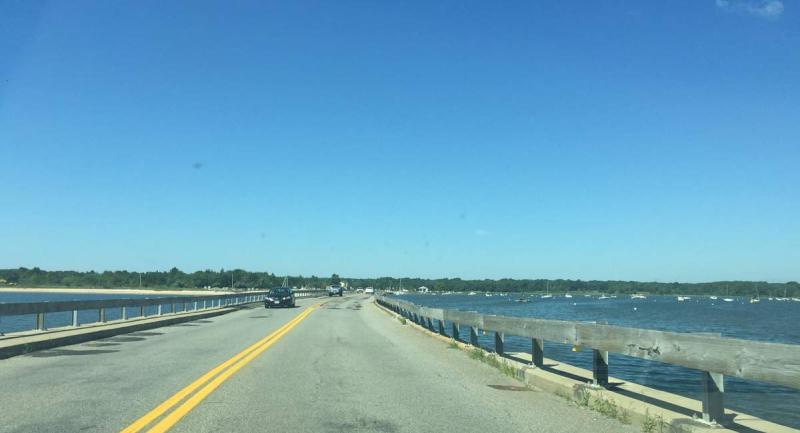Tracing the history of the Padanaram Causeway
Tolls per horse and rider, a beating from some of the worst hurricanes to strike Massachusetts, and of course, construction. That’s just some of what the Padanaram Causeway has been through in its nearly 200-year history of serving commuters in Dartmouth.
The causeway closed for its most recent round of renovations on August 1, severing Padanaram's direct connection to Gulf Road and Smith Neck, which dates back to 1828 with the establishment of the Dartmouth Bridge Company. The company was founded by a group of Dartmouth residents to build a bridge over the Apponagansett River, according to Massachusetts General Court records. An Old Dartmouth Historical Sketch identifies those residents as Nathaniel Howland, Caleb Anthony, Joseph A. Bailey, Gilbert Howland, Richard Sanford, Clark Ricketson and Luther Kirby.
After delays, construction on the bridge began on February 7, 1834. It was finished and opened in 1836, according to the historical sketch. It replaced an older ferry service that ran between opposite sides of the river operated by Charles Slocum, which provided Padanaram residents an easy way to cross the bay.
Beverly M. Glennon’s book “Dartmouth: The Early History of a Massachusetts Coastal Town” notes that this project only included connecting Padanaram with Apponagansett Point. It wouldn’t be until 13 years later that the Gulf Road Bridge would complete the connection that exists now from Gulf Road to Bakerville and Russells Mills Roads. In the meantime, those traveling over the bridge had to travel via Rock O’Dunee Road in order to get to Smith Neck from Padanaram.
Under the ownership of the Dartmouth Bridge Company, there was originally a toll to cross the bridge. Individuals could cross the bridge on foot for a cost of four cents. Those with animals or wagons had to pay a higher toll, ranging from eight cents for each horse and rider, to 25 cents for each coach, chariot or phaeton.
Tolling was intended to stay in place for 70 years after the completion of the bridge, but in 1870 the Town of Dartmouth purchased the causeway and bridge for $5,000 to be used as public roadway, according to Massachusetts General Court records and Glennon’s book. The tolling structure in place was abolished and the causeway was made into a free highway.
Over the years, the bridge has undergone a number of major renovations and reconstructions. In 1901, a project to build a new bridge began. According to the historical sketches and the Dartmouth Town Report from 1901, the town voted to move forward with a $40,000 project to build a new bridge.
According to the book "Greetings From Dartmouth, Massachusetts - A Postcard History,” the project involved changing the bridge’s support system and span. The historical sketches note that the new bridge was built with heavy stone pillars as supports, with iron railings lining the length of the bridge. It was built to resemble the previous bridge.
The causeway itself underwent a major renovation in 1904. According to an application to the Massachusetts Waterways Commission, the causeway was widened to 35 feet. The project involved building retaining walls and filling an area surrounding the causeway.
The town voted in the 1920 Town Meeting to build a new draw on the Padanaram Bridge. In the Finance Committee’s recommendation, members noted that “the draw is now unsafe and we recommend that the draw be reconstructed.” The town approved $22,500 to build a wooden draw bridge, and an additional $2,000 to repair the center pier.
Over the years, the causeway and bridge has seen its fair share of bad weather. The bridge and causeway was left damaged by the Great New England Hurricane of 1938, which made landfall off of Long Island on September 21 before hitting Massachusetts. According to the 1938 Town Report, the town spent $2,700 on repairs to reopen it quickly.
The causeway and bridge received a direct hit from Hurricane Bob in 1991 as well. According to a guide on hurricane preparedness from the Dartmouth Harbormaster, the Padanaram Bridge was left inoperable and impassable for about a week after the August 1991 storm.
In 1954, Hurricane Carol struck Massachusetts on August 31, and left the bridge closed for an extended period of time. Although the town was able to repair other town bridges through a special bond issue from the state, the Padanaram Bridge could not be repaired immediately because it was maintained under state Chapter 90 program, and the town did not have enough money in its Chapter 90 fund to conduct repairs, according to the 1954 Town Report. Eventually, the state agreed to help repair the Padanaram Bridge. It reopened in 1955, according to the 1955 Town Report.
The bridge received its most recent overhaul in the late 1990s. The town received a $1.02 million grant from the Massachusetts Highway Department to rehabilitate and repair the aging bridge, according to the 1995 Town Report. The renovations began in the spring of 1996. The town also spent $275,060 to repair the Gulf Road Bridge.
Both projects faced setbacks. In the 1997 Town Report, it was noted that the Gulf Road Bridge project faced delays amid poor performance by the general contractor before wrapping up in September 1997. The Padanaram Bridge project ran over budget, from $600,000 to $1.3 million after the state discovered that the state of the bridge was “deplorable” and other repairs were needed.
Delays continued for several years. In 1999, repair work reached a standstill after the state could not fund the project, according to the Town Report for that year. Components of the project that still needed to be completed included a $470,000 repair of the bridge deck and a $125,000 replacement of the underwater cable.
The project finally continued in November of 2000. Repairs to the deck required the causeway to be closed over the winter of 2000-2001. The entire project was completed in mid 2001.
The latest causeway project closed the bridge on August 1. The $8.2 million project will rebuild stone walls and railings, make improvements to the drainage system and will add two new culverts, according to MassDOT. The project is projected to finish by June 2018.




















